Cerclage compression wiring
1. General considerations
A partial articular fracture of the dorsal base of the middle phalanx without comminution may be stabilized with cerclage compression wiring.
A disadvantage of this fixation is the need to remove the wires as the construct is very bulky.
If the avulsed fragment is large enough, two 0.6 mm K-wires can be inserted to secure it to the main fragment of the middle phalanx. These K-wires can then be used to anchor the cerclage wire on the avulsed fragment. This will prevent tilting of the fragment on tightening of the wire.
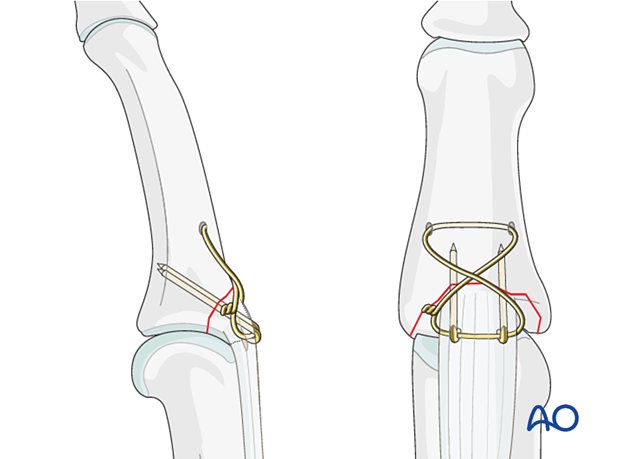
Recovery process
The recovery process after such injuries is slow. Advise the patient to expect 6–8 months for full recovery.
Tension band principle
The tension band converts tensile forces into compression forces.
In a case such as the illustrated fracture, the tension band will be applied in static mode.
Tension band wiring of this fracture has been shown to be effective and usually provides good results.
This form of fixation was referred to as a “Tension band fixation”. We now prefer the term “Cerclage compression wire fixation” because the tension band mechanism cannot be applied consistently to each component of the fracture fixation. An explanation of the limits of the tension band mechanism/principle can be found here.
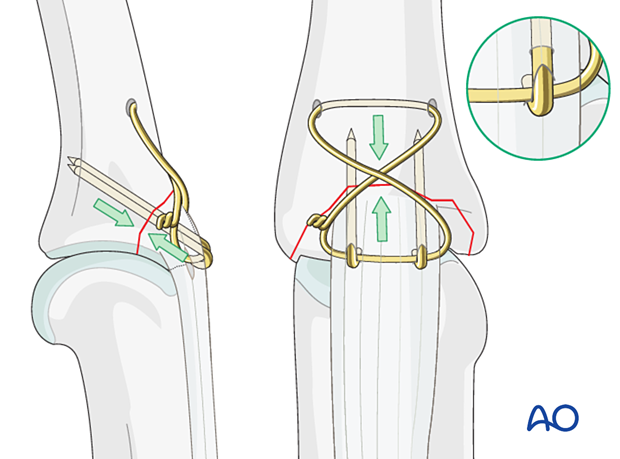
Alternative fixations
Anchor screwAn alternative way of anchoring the figure-of-eight wire distally in the phalanx is the use of a screw instead of a drill hole.
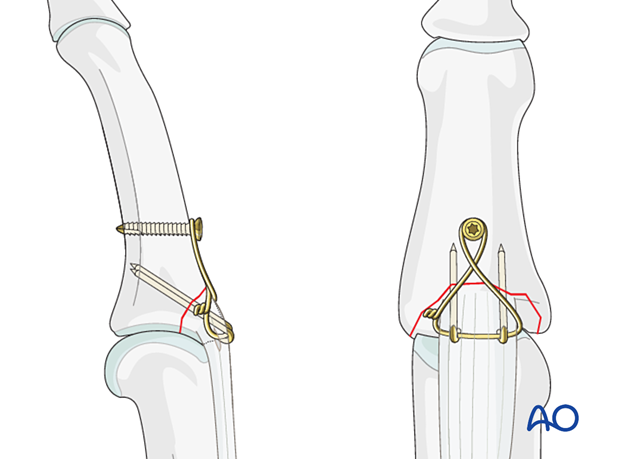
If the avulsed fragment is too small to risk further damage by passing a K-wire, a simple figure-of-eight tension band is used.
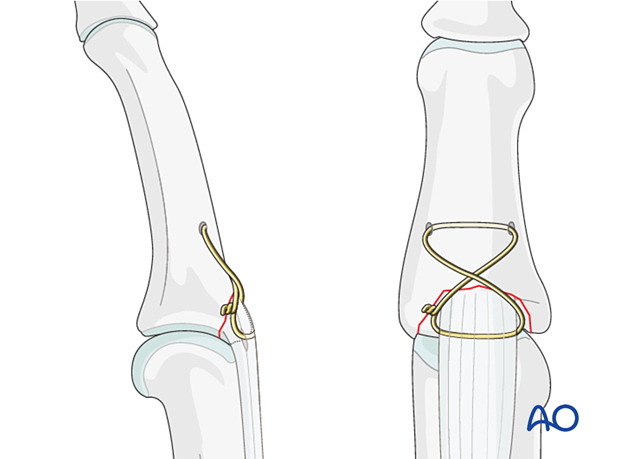
2. Patient preparation
Place the patient supine with the arm on a radiolucent hand table.
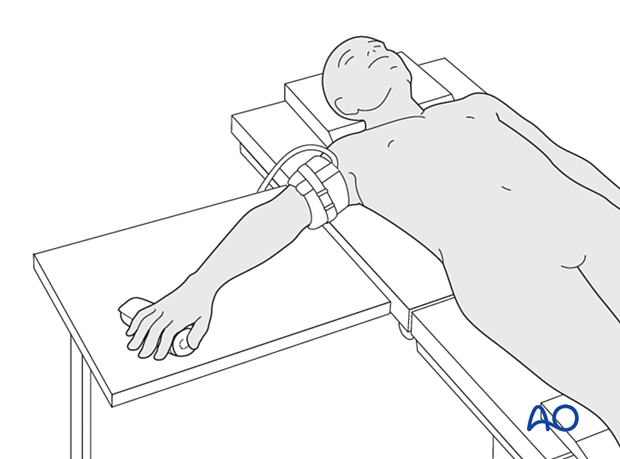
3. Approach
For this procedure a dorsal approach to the PIP joint is normally used.
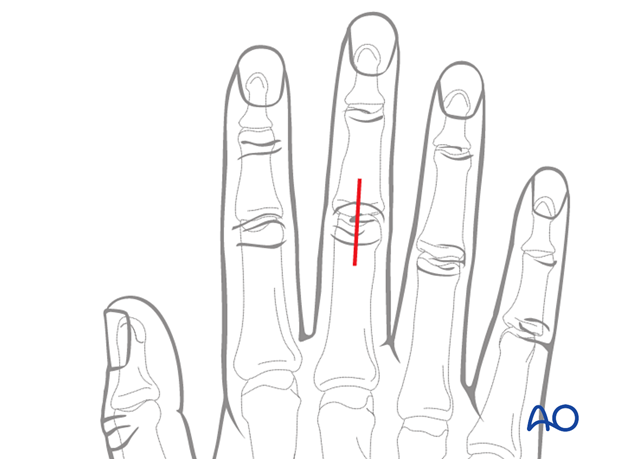
4. Reduction of dislocation
Dislocation usually occurs as a hyperflexion deformity.
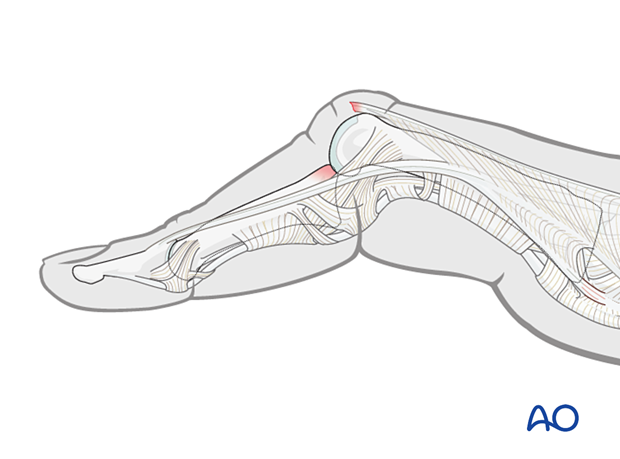
This can be reduced by increasing the deformity with some volarly applied pressure on the middle phalanx to reduce the joint. This keeps the collateral structures in tension and reduced the risk of soft-tissue interposition.
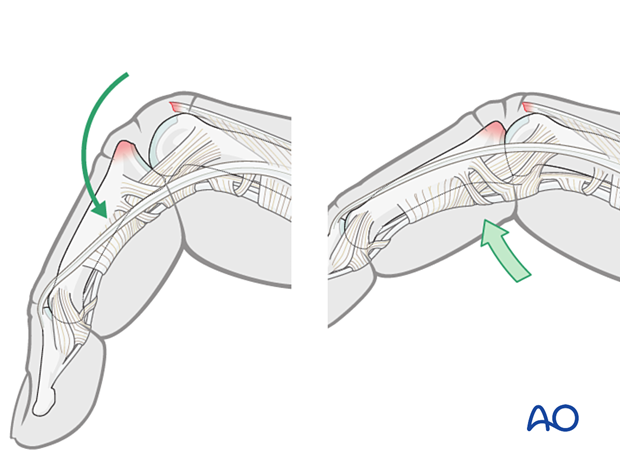
5. Fracture reduction
Visualizing the fracture
Flex the PIP joint to gain a better view of the fracture and the joint.
Often the presence of comminution is not apparent from the x-rays and can only be determined under direct vision.
Use a dental pick carefully to free interposed tissues, and to remove blood clot and other debris.
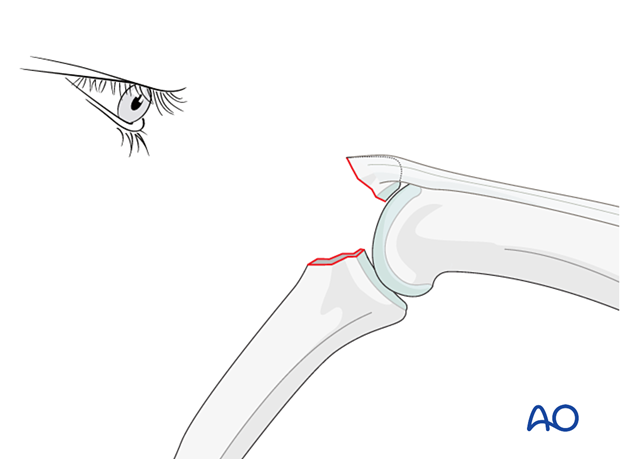
Fracture reduction
Extend the PIP joint and apply traction. Put manual pressure on the palmar side of the middle phalanx.
Complete the reduction with help of a dental pick.
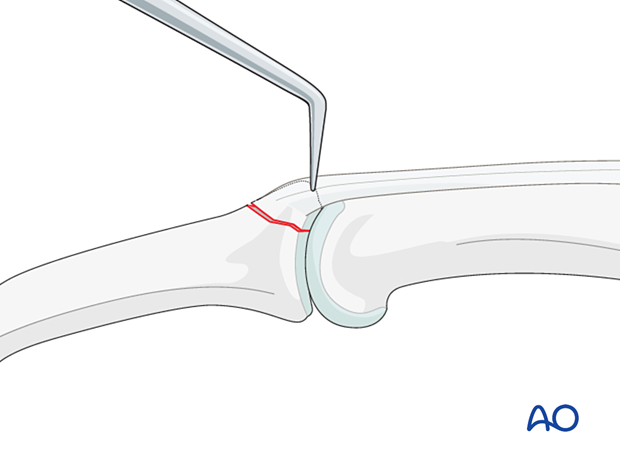
6. Wire fixation
K-wire insertion
Hold the reduction by inserting two K-wires through and perpendicular to the fracture surface. Make sure not to cross the far cortex.
Check reduction using image intensification.
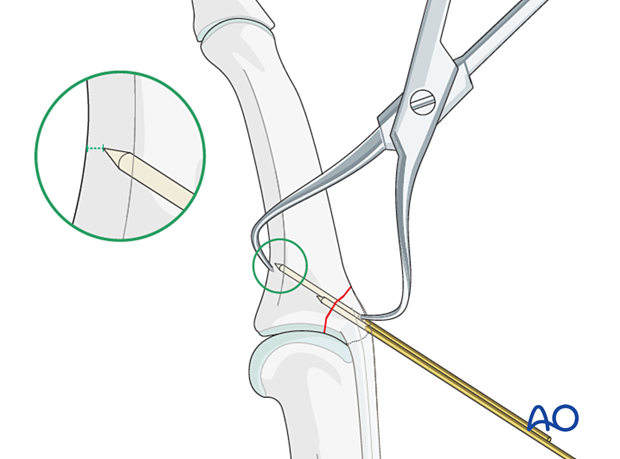
Drilling a transverse hole
Use a drill guide, for soft-tissue protection, and either a slow-spinning 1.5 mm drill, or a 1 mm K-wire.
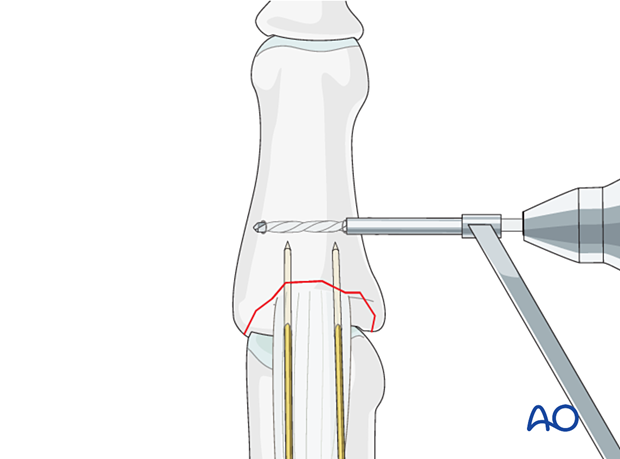
The location of the drill hole should be the same distance from the fracture line as the avulsed fragment’s length (usually approximately 1 cm). This will help the wires to cross above the fracture line, resulting in optimal force distribution.
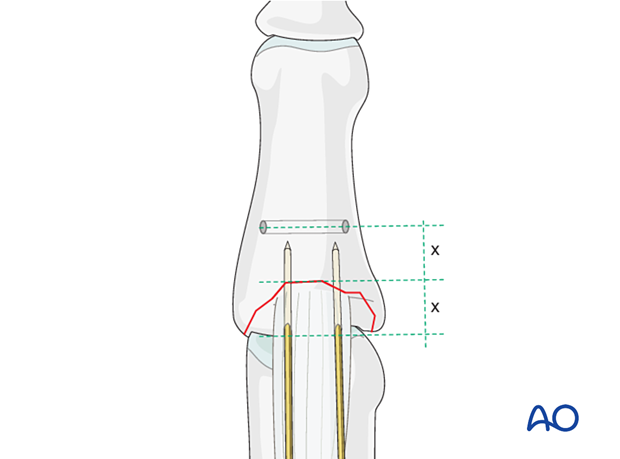
As the middle phalanx has a comparatively flat dorsal surface, it is sometimes difficult to drill a transverse hole.
As an alternative for anchoring the cerclage wire, a screw can be inserted approximately 1 cm from the fracture line. Follow standard screw inserting technique, including drilling and measuring. The screw must engage the far cortex. The screw head must protrude just enough for the wire to find anchorage.
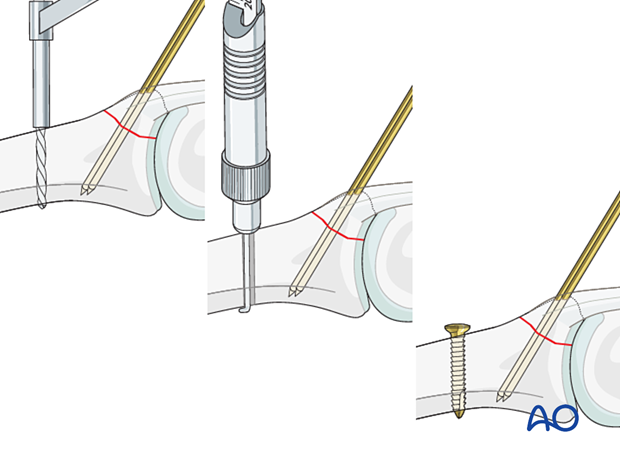
Wire insertion
Pass a 0.6 mm stainless steel wire through the hole. Alternatively, a 4.0 nonabsorbable multifilament suture can be used, double-mounted on a straight needle.
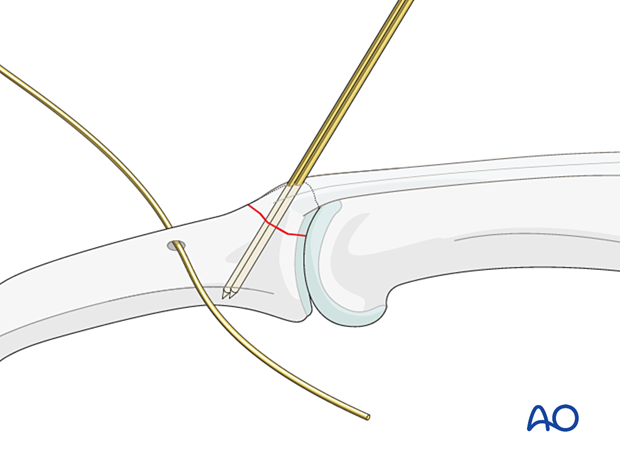
Passing the wire through the central slip
Pass the wire through the central slip and the K-wires, as close as possible to its insertion into the bone. A 21 hypodermic needle can be used to pass the wire through the tendon as close as possible to the bony fragment.
Do not place the wire on top of the central slip, as this may cause necrosis by pressure.
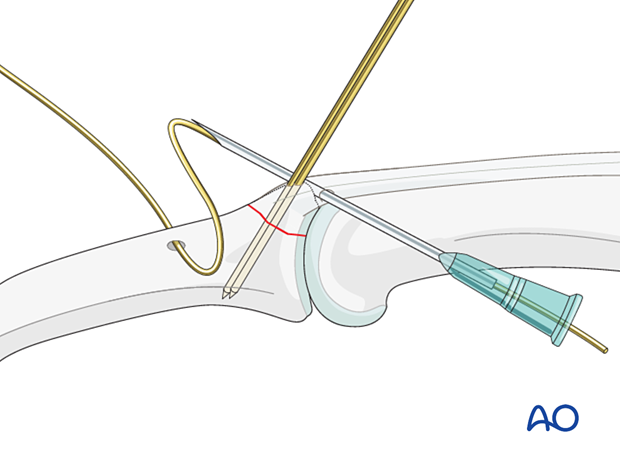
Anchoring the K-wire
Check the position of the K-wire using image intensification. If the tip of the wire is in contact with the far cortex, then retract the K-wire by about 2 mm, bend it through 180°, cut the wire to form a small hook, and impact the bent tip into the bone.
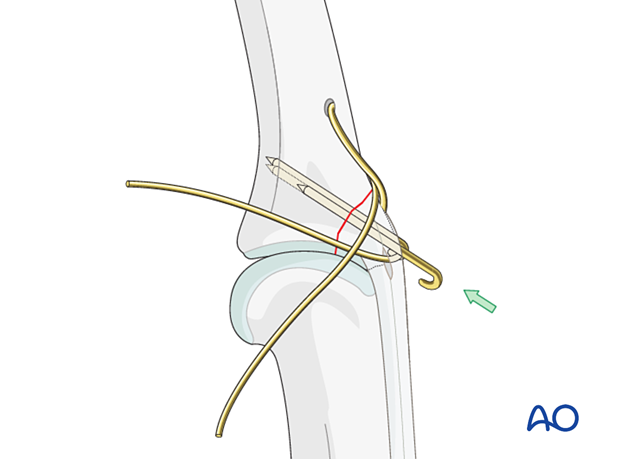
Tightening the wire
Once the fragment is reduced, the wire loop is tightened, cut short, and bent along the phalanx, to avoid soft-tissue irritation.
When tightening the wire, ensure that both ends are twisted around each other rather than twisting one end around the other straight end.
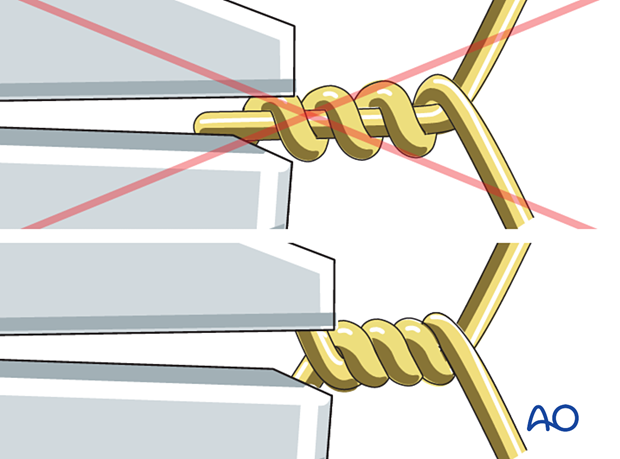
This is achieved by using traction with the pliers to tighten the loop and the twisting, still under tension, to take up the slack.
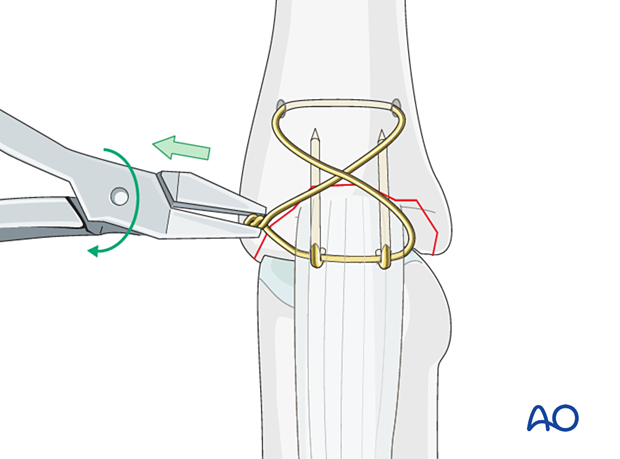
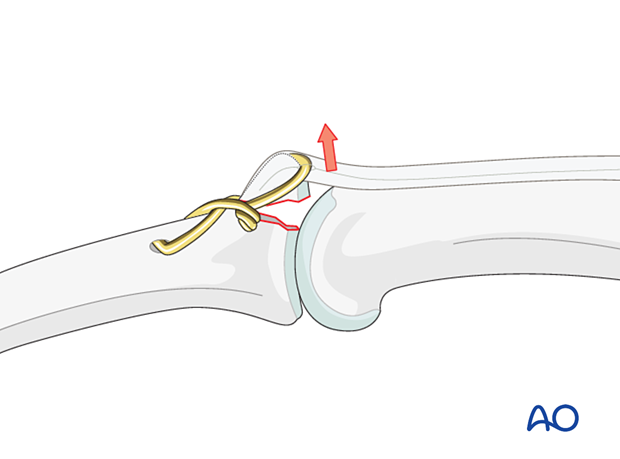
7. Joint transfixation with K-wire
A joint transfixation may help to protect the fixation.
In case of any joint instability, insert a K-wire obliquely crossing the PIP joint, with the finger in extension to protect the central slip reattachment.
Leave the end of the K-wire outside of the skin for later removal.
The K-wire can be removed after 3–4 weeks.
The fixation should be protected with a splint to reduce the risk of wire breakage.
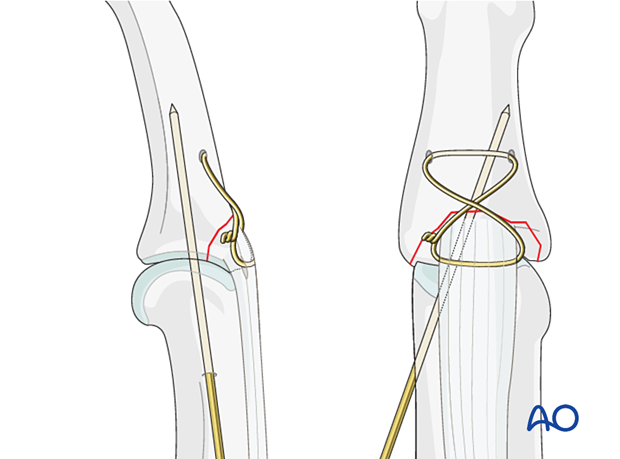
8. Final assessment
Check joint congruity using image intensification. Reduction must be anatomical.
9. Aftercare
Postoperative phases
The aftercare can be divided into four phases of healing:
- Inflammatory phase (week 1–3)
- Early repair phase (week 4–6)
- Late repair and early tissue remodeling phase (week 7–12)
- Remodeling and reintegration phase (week 13 onwards)
Full details on each phase can be found here.
Postoperatively
The hand is supported with a dorsal splint for 6 weeks. This should permit movement of the unaffected fingers. The arm should be actively elevated to help reduce the swelling.
The hand should be immobilized in an intrinsic plus (Edinburgh) position:
- Neutral wrist position or up to 15° extension
- MCP joint in 90° flexion
- PIP joint in extension

The MCP joint is splinted in flexion to maintain its collateral ligaments at maximal length to avoid contractures.
The PIP joint is splinted in extension to maintain the length of the volar plate.

Follow-up
When a K-wire has been used, it is removed after 4 weeks. X-rays are taken to confirm articular congruency. Unlimited flexion is encouraged after wire removal.
In the middle phalanx, the fracture line can be visible in the x-ray for up to 6 months. Clinical evaluation (level of pain) is the most important indicator of fracture healing and consolidation.
Active flexion of the PIP joint is initiated by using a dorsal extension block splint at 30°. This will need to be delayed until any K-wire has been removed.
After 6 weeks, the splint is removed, and unrestricted active extension is permitted.
If active extension is still restricted after 6 weeks, then dynamic extension splinting is recommended.
Mobilization
During the whole process, after removal of any K-wire, the hand therapist should closely monitor the rehabilitation.
DIP joint movement is encouraged immediately to avoid extensor tendon adhesion and joint stiffness.
Active mobilization is initiated after splint removal. Functional exercises are recommended.
Sporting activities are allowed only after 3 months, and buddy strapping is recommended.
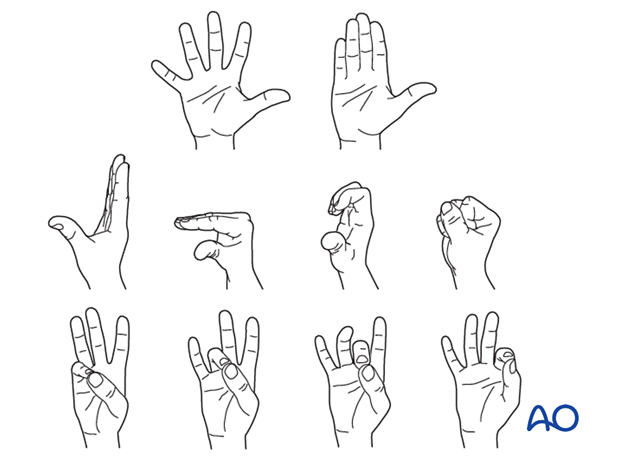
Implant removal
The wires may need to be removed in case of soft-tissue irritation, but not before fracture consolidation.













